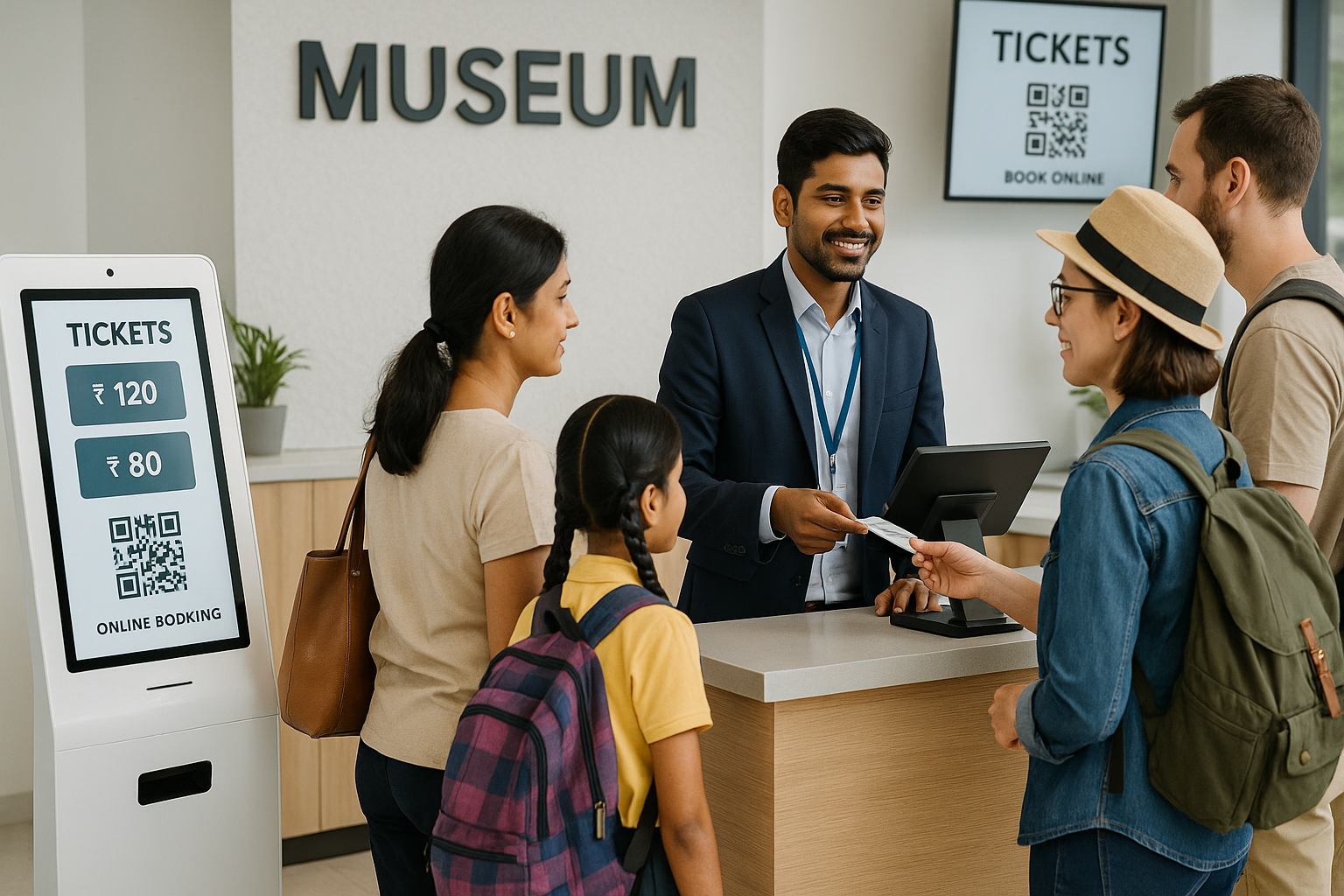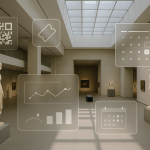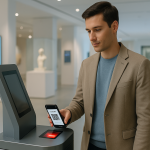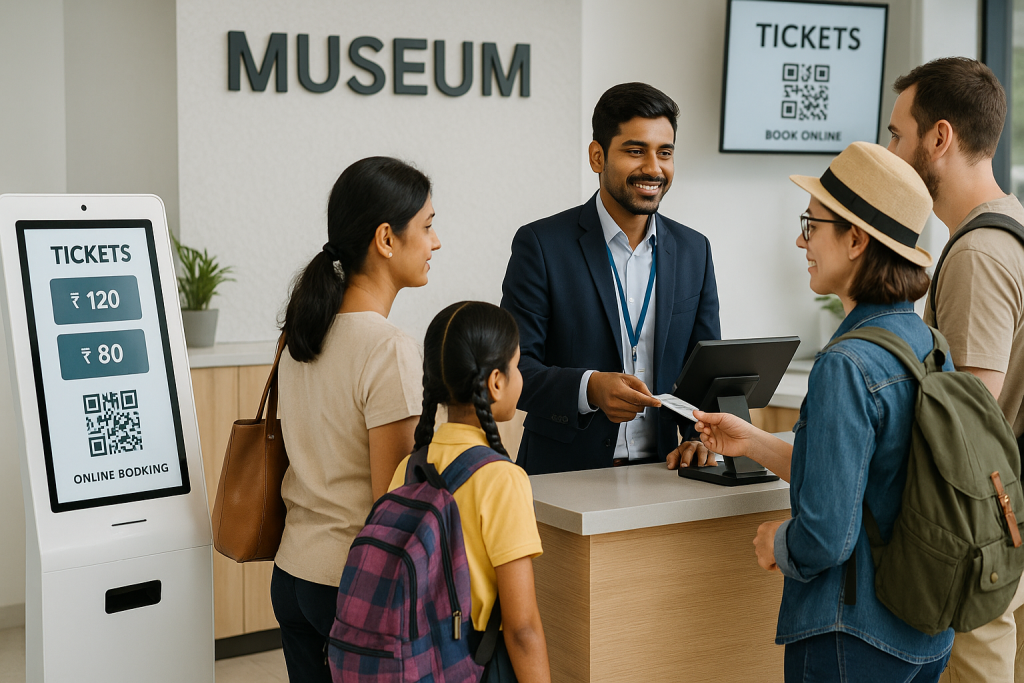Despite rising footfall, most Indian museums still lack a robust museum ticketing system to manage it all. For instance, school visits alone made up 21.53% of total visitors at the Indian Museum in 2024–2025 and that’s just one audience segment.
From school field trips to international tourists, the demand for streamlined visitor experiences is growing fast. But behind the scenes, many museums still rely on manual ticket counters, fragmented online systems, and basic point-of-sale setups slowing down both staff and guest experiences.
If you’re managing a museum today, you’re likely juggling:
- Offline ticketing with cash-only POS
- Third-party online bookings that don’t sync in real time
- Manually tallied visitor data or Excel sheets
This patchwork often leads to long queues, reporting delays, and lost revenue opportunities from walk-ins and upsells. The good news? A single system can now do it all.
In this blog, we’ll walk you through what a complete museum ticketing system looks like—one that combines online booking, in-person POS, and cloud-based visitor management. It’s the future-proof setup Indian museums need today.
What Makes a Museum Ticketing System “Complete”?
Not all ticketing tools are built for museums. Many are just basic booking forms or retail-style POS software with limited support for timed entries, visitor caps, or reporting.
A complete museum ticketing system goes beyond selling tickets — it helps you manage the entire visitor journey across both online and offline channels. Here’s what to look for:
1. Online Booking Engine (Mobile-Optimized)
Let visitors book from anywhere — whether it’s school coordinators planning group tours or tourists searching on their phones. A good booking system should:
- Offer custom time slots
- Support UPI, credit/debit cards
- Auto-send e-tickets with QR codes
2. Integrated Point-of-Sale (POS) for Onsite Sales
Your front desk staff should be able to sell tickets, accept payments, and print receipts — all in one system. A good POS system for museums:
- Accepts multiple payment methods (cash, UPI, cards)
- Works offline-first in case of connectivity drops
- Syncs instantly with the online booking dashboard
3. Real-Time Visitor Management
Track entries with QR code scanners or self-service kiosks. This ensures:
- No ticket duplication or overbooking
- Smooth group check-ins
- Accurate attendance logs for reporting
4. Centralized Reporting Dashboard
Fragmented tools lead to messy reports. A unified dashboard should show:
- Daily ticket sales (online + offline)
- Peak visiting hours
- Inventory or add-on sales (like gift shop items)
5. Support for Kiosks + Mobile Devices
Modern museums often use tablet-based check-ins or touch-screen kiosks. The system should be compatible with:
- Self-service ticket printing stations
- Handheld scanners for staff
- Multilingual prompts (especially in India)
Why it matters:
This feature set ensures a frictionless experience for both visitors and staff and makes life easier for museum managers who need fast, accurate reports without juggling spreadsheets.
Common Pain Points in Traditional Museum Ticketing Systems
Most museums today aren’t struggling because of a lack of effort — they’re struggling because their systems were never built to handle both physical and digital ticketing in one flow. Whether it’s a national gallery or a regional heritage site, these are the most common roadblocks:
1. Disconnected Online and Onsite Systems
Many museums use one tool for online booking and another for onsite ticket sales. These systems rarely talk to each other, creating:
- Confusion during check-ins
- Duplicate ticketing
- Data scattered across platforms
2. Long Queues and Manual Entry Logs
Without real-time syncing, staff are forced to:
- Check visitor names manually
- Accept only cash or limited payments
- Manage long lines during school visits or special exhibits
This leads to frustrated guests and overworked front-desk teams.
3. Delayed Reports and Fragmented Data
When your team uses Excel sheets, WhatsApp updates, and handwritten ledgers to track visitor numbers, you’re flying blind. Managers face:
- Inaccurate daily attendance
- No real-time visibility into sales
- Difficulty forecasting staff or inventory needs
4. Missed Opportunities for Upselling
Without a smart POS system, museums miss out on:
- Bundling entry with guided tours
- Promoting merchandise during checkout
- Tracking which items or time slots perform best
These issues don’t just hurt operations—they affect visitor satisfaction, revenue growth, and your ability to scale or digitize in the future. If your museum faces even two of these problems, it’s time to consider a unified solution.
Benefits of an Integrated POS & Online Booking System
A unified museum ticketing system doesn’t just make operations smoother — it directly improves visitor experience, staff efficiency, and revenue tracking. Let’s break down how:
1. Faster Check-Ins, Shorter Queues
When visitors arrive with a QR code ticket on their phone, staff can scan and allow entry in seconds. No printed lists. No manual logging.
Result: You reduce bottlenecks during peak hours and improve the first impression.
2. Real-Time Sales + Attendance Reporting
With both POS and online bookings connected, you get a single dashboard that updates in real-time.
Result: You can track:
- Total tickets sold (by channel)
- Current visitor count inside the museum
- High-traffic time slots
No spreadsheets. No guesswork.
3. Simplified Payments (Cash + UPI + Cards)
An integrated POS supports India’s preferred payment modes:
- UPI (Google Pay, PhonePe, etc.)
- Credit/Debit Cards
- Cash for walk-ins
Result: Every sale is recorded, reconciled, and report-ready — no end-of-day headaches.
4. Automated Reconciliation
No more tallying online and offline tickets manually. The system auto-syncs both sales streams into one report.
Result: Clean audit trails and faster financial reporting.
5. Increased Revenue Through Add-Ons
Museums with integrated POS systems can upsell:
- Guided tours
- Merchandise
- Audio guides or AR experiences
Result: Higher per-visitor revenue with minimal effort.
Whether you’re a government-funded heritage site or a privately run gallery, a complete system removes operational friction while unlocking new growth channels and gives your team time back to focus on what matters most: the visitor experience.
Why Indian Museums Need Cloud-Based Systems Now
Over the past few years, India’s cultural institutions have made steady progress in adopting digital solutions from e-ticketing at ASI monuments to virtual exhibitions at national museums. Visitors today expect more than just a ticket; they expect speed, flexibility, and convenience.
Yet many museums are still held back by legacy systems that are:
- Installed on local desktops
- Hard to update or access remotely
- Dependent on IT teams for every change
Here’s why cloud-based ticketing systems are the future and the present.
1. Access Anywhere, Anytime
Cloud-based systems run on browsers and apps — no need for bulky hardware or local servers.
Result: Your team can manage bookings, POS, and reports from front desks, tablets, or even mobile phones.
2. Zero Maintenance, Always Updated
Forget about manual updates or downtime. Cloud platforms like EveryTicket push updates instantly — no technicians required.
Result: You always have the latest features and security patches.
3. Perfect for Multi-Location or Mobile Teams
Whether you’re hosting a traveling exhibit or running a museum with multiple galleries, cloud systems keep everything synced — across staff, devices, and departments.
Result: Everyone works from the same data, in real-time.
4. Built for India’s Digital Payments Ecosystem
Cloud-native tools are designed to plug into India’s fast-evolving digital infrastructure — from UPI payments to SMS ticket delivery.
Result: No need to bolt on outdated POS hardware or fight with integration issues.
For Indian museums looking to modernize without the high cost of IT overhauls, cloud-based systems offer the lowest effort, highest impact way to digitize operations.
How EveryTicket Solves It All
If your museum is facing long queues, disjointed systems, or clunky reporting — you’re not alone. That’s exactly why we built EveryTicket: a ticketing platform designed specifically for museums in India, combining everything you need into one seamless system.
Here’s how EveryTicket makes life easier for your team and better for your visitors.
Unified Ticketing: Online + Onsite
- Offer mobile-friendly online booking for visitors in advance.
- Handle on-the-spot sales with our integrated POS at the counter.
- All tickets — whether sold online or offline are stored and synced in one place.
Smooth Check-ins with QR Codes or Kiosks
- Visitors can scan QR codes directly from their phones.
- Support for self-service kiosks reduces front-desk workload.
- Real-time visitor tracking ensures zero overbooking.
Fast, Flexible Payments
- Accepts cash, cards, and UPI out of the box.
- Designed for the Indian visitor — no plugins or third-party hacks needed.
- Every transaction is auto-logged for simple end-of-day reports.
Powerful Reports in One Click
- Track ticket sales by type, date, and time slot.
- Monitor visitor flow and identify peak hours.
- Export reports for audits or grant reporting — no Excel wrangling required.
Fast Setup, Minimal Training
- Cloud-based: No IT infrastructure needed.
- Staff onboarding in hours, not weeks.
- Works across desktops, tablets, and kiosks.
Whether you’re managing a single-location museum or a multi-gallery institution, EveryTicket helps you go live faster with everything you need to modernize your visitor experience and operations.
A Day in the Life: A Visitor Journey with EveryTicket
Let’s bring it all together with a simple, real-world example. Here’s how a typical museum day looks with EveryTicket running in the background:
9:00 AM – A Family Books Online
A family from Ahmedabad discovers your museum on Google. They quickly book four tickets through your mobile-friendly booking page, selecting a 3 PM slot. They pay via UPI and instantly receive e-tickets on WhatsApp and email — each with a unique QR code.
11:00 AM – A School Group Arrives
A school bus pulls up with 30 students. The front desk team uses EveryTicket’s POS system to issue group tickets, accepting payment by card and generating a receipt within seconds. The visitor log is updated in real-time.
3:00 PM – Family Check-In
The family from the morning booking arrives. At the entrance, they scan their QR codes using a self-service kiosk. Their check-in is confirmed automatically — no queues, no confusion.
6:00 PM – Instant Report Generation
As the museum winds down, the manager logs into EveryTicket’s dashboard. With one click, they see:
- Total tickets sold (online vs counter)
- Visitor footfall per hour
- POS revenue breakdown
No need to compile logs or tally cash slips — it’s all done.
EveryTicket doesn’t just power your ticketing — it powers your day.
From bookings to check-ins to backend reports, the entire workflow runs smoother, faster, and with zero duplication or data loss.
Buyer’s Quick Checklist: What to Look for in a Museum Ticketing System
Choosing the right system isn’t just about features — it’s about finding a solution that fits your museum’s workflows, visitors, and team capacity.
Here’s a quick checklist to guide your decision:
- Unified Ticketing: Can it manage both online bookings and on-site ticket sales in one platform?
- POS Integration: Does it support multiple payment options — including UPI, cash, and cards?
- Mobile + Kiosk Support: Can staff use tablets or can visitors check in via self-service kiosks?
- Real-Time Reporting: Is there a central dashboard for sales, attendance, and revenue tracking?
- India-Ready Features: Does it work with Indian payment systems and provide local support?
- Fast Setup + Easy Onboarding: Can your team learn and go live within days, not weeks?
If your current system can’t tick most of these boxes, it’s time for an upgrade — and EveryTicket was built to meet all of them, right out of the box.
Real-World Impact: How EveryTicket Helped MAP Bangalore
When the Museum of Art & Photography (MAP) in Bangalore — one of India’s most prominent private art museums needed a ticketing solution customized to both their physical exhibitions and digital-first visitor base, they chose EveryTicket.
Our team worked closely with MAP to:
- Implement a custom online booking experience
- Set up on-site POS integrated with their visitor flow
- Enable real-time reporting for both ticket sales and check-ins
- Support multi-lingual ticketing and digital kiosks
Result: MAP now runs both their online and offline ticketing on a single platform improving visitor flow, simplifying staff operations, and giving the management team complete visibility into daily performance.
Ready to Upgrade Your Museum Ticketing System?
Managing a museum in 2025 means more than just printing tickets — it means delivering a seamless visitor experience, having real-time visibility into your operations, and accepting modern payments that your guests expect.
With EveryTicket, you get a complete, cloud-based solution that:
- Connects your online and on-site ticketing
- Speeds up check-ins and reduces staff workload
- Supports UPI, cash, and card payments natively
- Works across desktops, kiosks, and mobile devices
And the best part? You can go live in days — not months.
Start today:
Fill out the inquiry form to book a demo.
FAQs
1. What is a museum ticketing system?
A museum ticketing system helps you manage visitor bookings, issue tickets (both online and offline), process payments, and track attendance — all in one place.
2. What is the difference between online booking and POS?
Online booking is done in advance by visitors on a website or app, while POS (point-of-sale) is used by staff at the museum counter to issue tickets on the spot.
3. Can Indian museums accept UPI payments?
Yes. EveryTicket is built to support India’s popular digital payment methods, including UPI, RuPay, credit/debit cards, and cash.
4. How long does it take to set up a cloud-based ticketing system?
With EveryTicket, you can go live in just a few days — with minimal setup, onboarding, or IT involvement.
5. Do self-service kiosks really reduce front-desk workload?
Absolutely. Kiosks let visitors check in by scanning QR codes or booking tickets themselves, cutting down queues and freeing up staff time.



